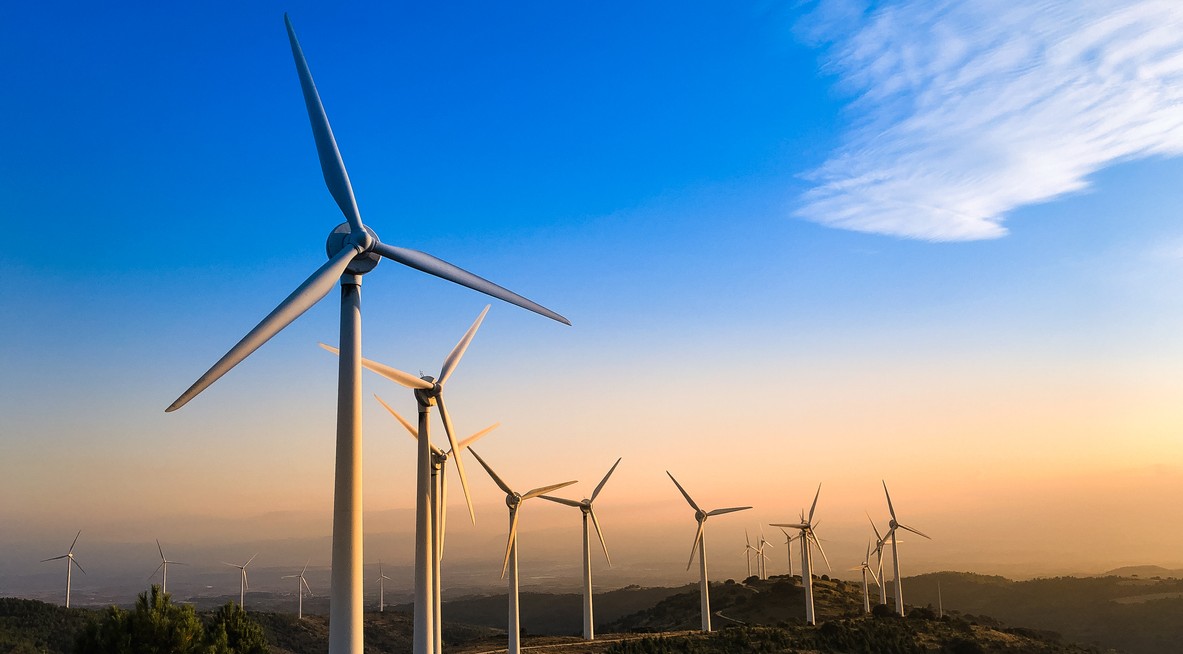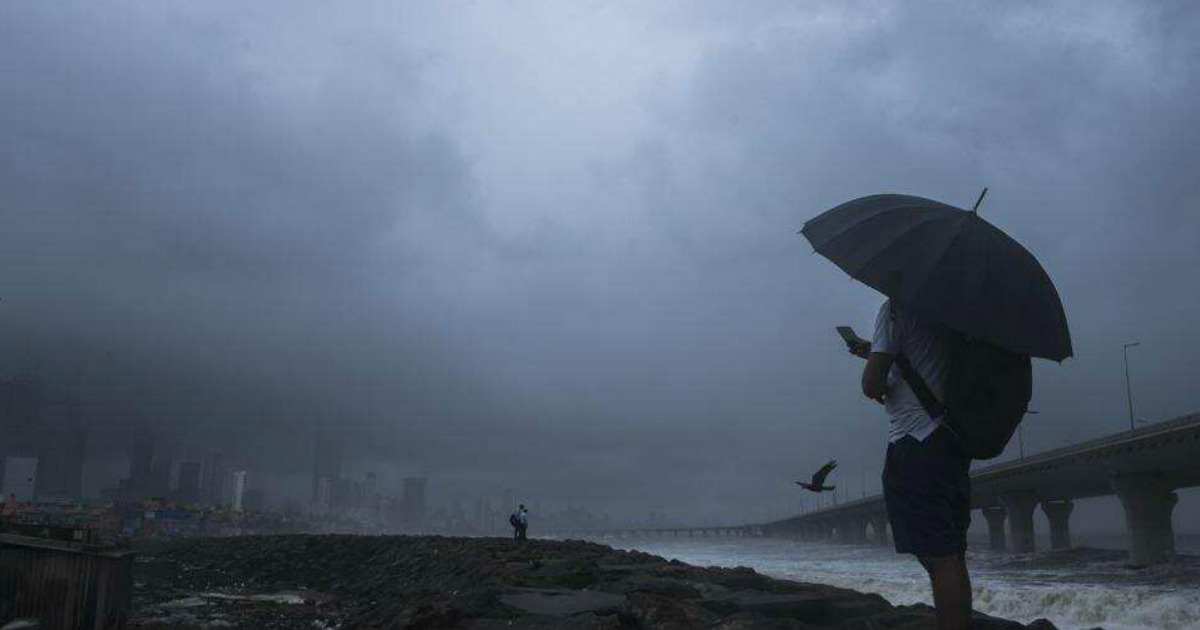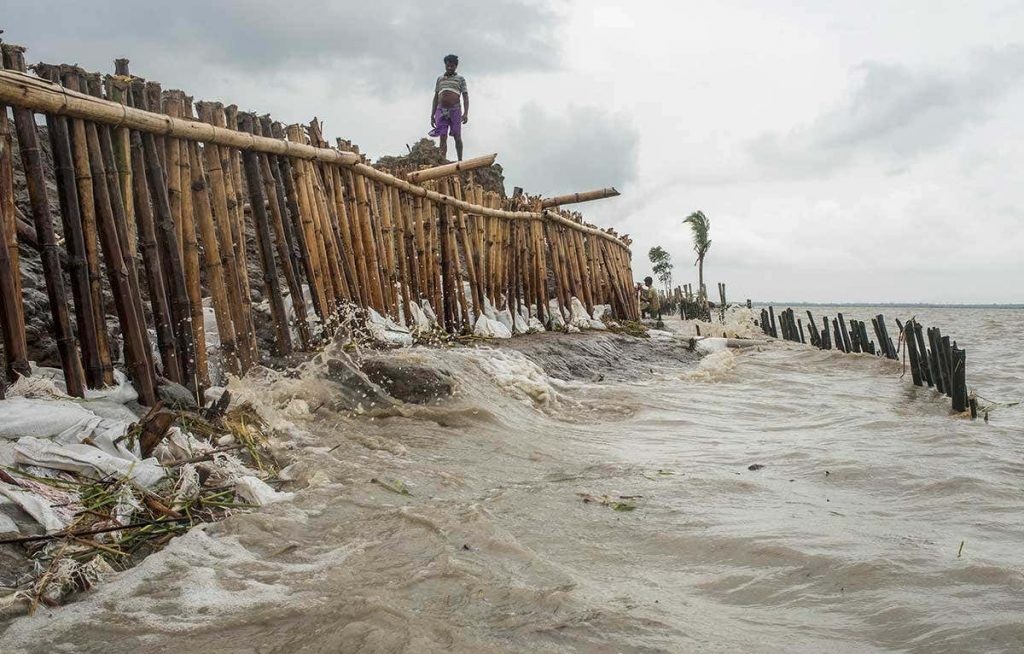Climate change plays key role in deteriorating Delhi's air quality by altering weather patterns
Climate change will continue to alter atmospheric circulations and precipitation patterns, subsequently influencing the occurrence of weather patterns that worsen air quality, especially over the Indo-Gangetic Plains.
By Kartiki Negi / Nov 25, 2024
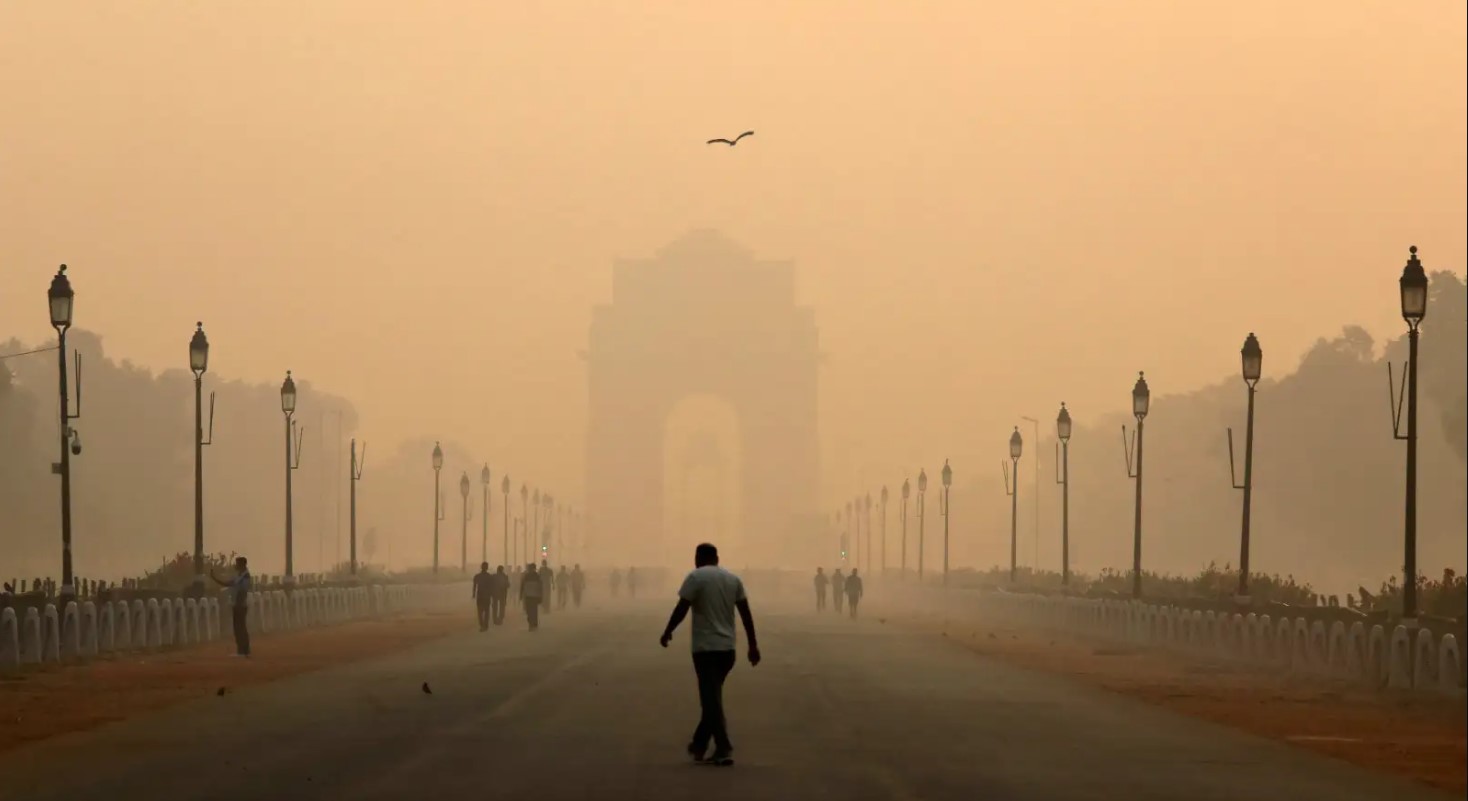
Image Courtesy: Quartz
Delhi's air quality has been making to the headlines for several years now. 2024 has been no different, with city witnessing its first spell of bad air quality as it stepped into the second half of November. On November 18, Delhi air quality plunged to hazardous levels, with the city witnessing the season’s highest average AQI (Air Quality Index) at 495. India’s top court had enforced the sternest Graded Response Action Plan (GRAP) 4 restrictions across the city till further notice to tackle alarming AQI levels.
Despite slight improvement, Delhi-NCR will continue to struggle with bad air quality, as experts predict that AQI will continue to settle in the 'Poor' to 'Very Poor' category in the coming days. According to scientists, Meteorological conditions are likely to remain extremely unfavourable for the effective dispersion of pollutants.
Role of Meteorology: Early arrival of smog this season
While meteorological conditions that included good wind speed and easterly wind direction favoured the national capital earlier this season, the similar conditions are now responsible for plummeting AQI levels. Meteorological conditions regulate the accumulation, transport, and removal of emitted air pollutants. In conjunction with emissions, they drive observed PM2.5 variability on hourly to interannual scales. Atmospheric stagnation, characterised by a lack of precipitation, weak surface winds, and limited vertical mixing, is particularly influential in driving the buildup of pollution near the surface. Stagnation events can, therefore, exacerbate PM2.5 pollution, even without abrupt emission increases.
Delhi usually witnesses a peak in AQI levels around Diwali, which also coincides with the peak of stubble burning in the neighbouring states of Punjab and Haryana. This season, good wind speed spared Delhi-NCR record-breaking high levels of pollution during Diwali. Thereafter, winds changed from a north-westerly direction to an easterly or southeasterly across the Indo-Gangetic Plains, which led pollutant-laden winds towards Pakistan.
However, weather conditions changed subsequently. Smog made an early appearance over the northwestern plains this year.
The continuous flow of easterly winds over the plains had increased the moisture level. This was followed by the arrival of a feeble Western Disturbance (WD) that continued to infuse humidity over the region. Post the departure of WD, clear sky and cool north-westerly winds led to a cooling of the surface and a dip in mercury. All this, when combined with moisture present in the atmosphere, led to the formation of fog over the northwestern plains of Northwest India. Winds picked up a slight pace on the evening of November 17, pushing fog across Delhi-NCR and calming down again.
“We usually witness such foggy conditions over the northern plains by the end of November or early December. During this season, initially, the easterly winds and then the passage of western disturbances (WD), although feeble, kept infusing moisture over the plains at regular intervals, paving the way for favourable conditions for the formation of smog,” said Mahesh Palawat, Vice President - Meteorology and Climate Change, Skymet Weather.
Fog is a condensed form of water vapour in the air, trapping the pollutants over the earth’s surface. This is then known as ‘smog’. Calm winds were unable to disperse the pollutants from the atmosphere that remained suspended in the atmosphere for a longer duration.
Calm wind conditions also enhance the accumulation of water vapour in the atmosphere in a highly humid environment, which helps the fog droplets to be exposed for a more extended period in the atmosphere thereby absorbing significantly higher concentrations of air pollutants. Also, Chilly days could trap the plains in the vicious smog circle, which means consecutive days of bad air quality would persist.
Prof S N Tripathi, Dean, Kotak school of sustainability, Indian Institute of Technology-Kanpur explained that the particulate matter (PM) changes its property after coming in contact with fog, paving way for more fog. “With winters intensifying, the situation is likely to aggravate as more cold weather is associated with relatively high humidity, which increases the possibility of particulate matter (PM) holding more water. After the fog disappears, water vapour or droplets evaporate leaving the PM behind. However, a very tiny chemistry takes place here, making PM more oxidised. There is a strong relation between oxidised PM and fog condensation nuclei as compared to non-oxidized components. In fact, smaller droplets oxidise faster and oxidised PM are more efficient and thus formation of fog would be much easier than the previous day. All these conditions would result in a vicious smog circle, wherein we would not see clearance for days and that is what we witnessed in the last few days.”
Dip in temperature and absence of winter rains
Persistent fog cover has led to a substantial dip in the maximum as well as minimum temperatures across the plains including Delhi-NCR. “Drop in mercury paves the way for stagnant conditions in the atmosphere and these cooler conditions inhibit vertical mixing within the atmosphere. With this, there are higher possibilities for air quality across the region,” said Dr V Vinoj, Assistant Professor, School of Earth Ocean and Climate Sciences, Indian Institute of Technology Bhubaneswar.
Meteorologists are expecting a further drop in the minimum temperatures in the coming days. “With cold north-westerly winds reaching the plains, minimum temperatures will drop further. With this, dispersing pollutants from the atmosphere would be very difficult. The more the minimum temperatures dip, thicker will be the inversion layer. And the thicker the inversion layer, it would be more difficult for sun rays or winds to penetrate through this layer and disperse the pollution level,” said Palawat.
During winters, the air in the planetary boundary layer (the lowest part of the atmosphere) is thinner as the cooler air near the earth’s surface is dense. The cooler air is trapped under the warm air above, forming a kind of atmospheric ‘lid’. This phenomenon is called winter inversion. Since the vertical mixing of air happens only within this layer, the pollutants released lack enough space to disperse in the atmosphere.
Precipitation is also the natural way of washing out pollutants from the atmosphere. However, rains have remained absolutely absent so far in the season. Delhi has recorded no rainfall from October 1 to November 19. Furthermore, no respite is in offing as rains remain far and distant.
“So far, all the Western Disturbances, which govern the rain patterns across North India, have been feeble in nature and have not been able to give widespread weather activities. We did see some rain and snow over the upper reaches of Jammu and Kashmir, but nothing beyond that. Absence of rains fails to wash-out the pollutants from the atmosphere, allowing them to stay for a longer period and causing early smog like conditions,” added Palawat.
Climate Change to further intensify pollution levels across Indo-Gangetic Plains (IGP)
Climate change is projected to alter atmospheric circulation and precipitation patterns, subsequently influencing the occurrence of weather patterns that worsen air quality, especially over the Indo-Gangetic Plains.
According to a recent study, ‘Impacts of current and climate induced changes in atmospheric stagnation on Indian surface PM2.5 pollution’, climate change is anticipated to alter future atmospheric stagnation patterns, impacting the effectiveness of air quality policies. The study finds that future stagnation changes result from both global CO2-driven circulation changes and local aerosol-driven meteorological responses. By 2100, the study projects an increase in winter stagnation in the Indo-Gangetic Plain (IGP) of 7 ± 3 days that leads to an increase in PM2.5 of ~7 ug/m3 in a high-warming and high-aerosol scenario.
During winters, climate-induced reductions in surface wind speed are significant in the IGP, contributing to an increase in weak dispersion days—and thus more stagnation days—under both SSP (Shared Socioeconomic Pathways) scenarios.
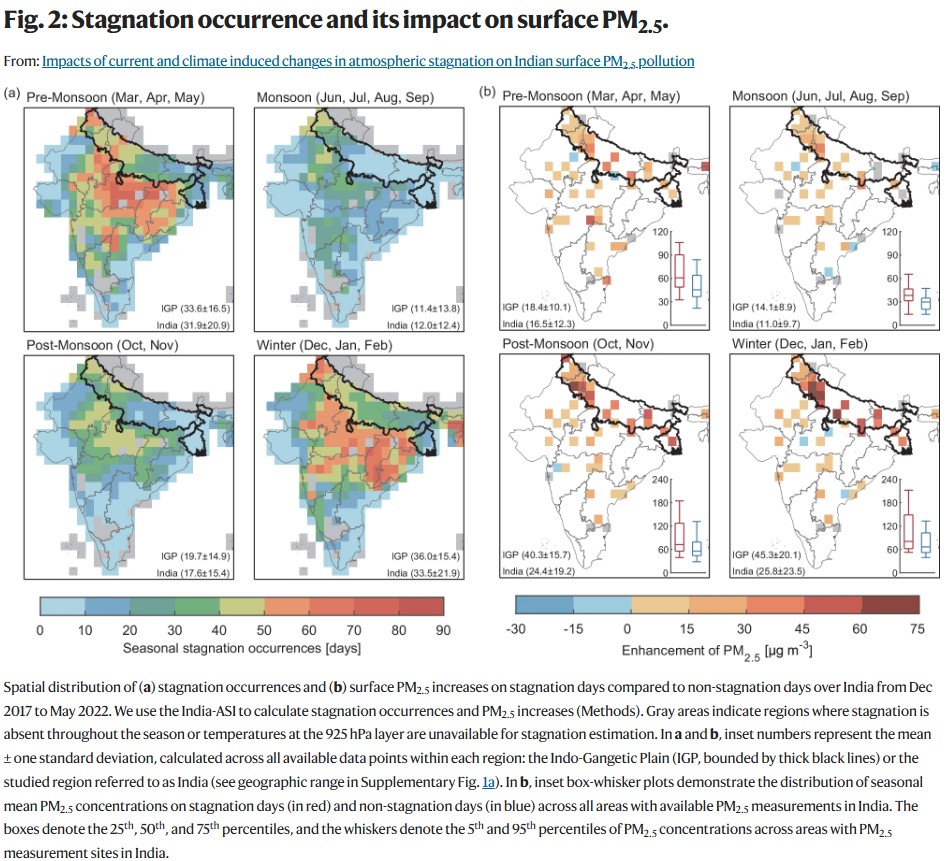
During winter, warming-induced changes in temperature inversions are minimal over most areas in India, while reductions in both precipitation days (more dry days) and surface wind speed (more weak dispersion days) are evident in the IGP, leading to ~1 ± 1 more winter stagnation day per 1 °C of global warming.
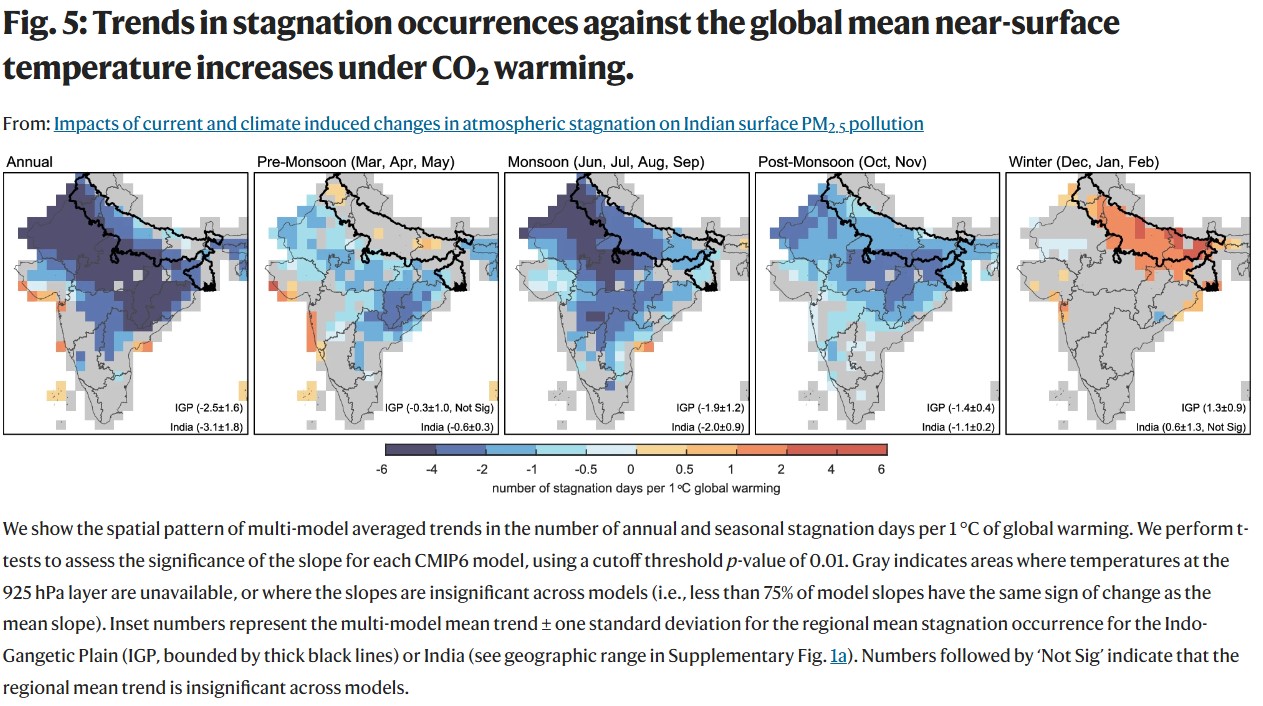
Beyond the sea level pressure (SLP) -induced changes, both the frequency and intensity of western disturbances—synoptic systems crucial for winter precipitation—are projected to decline with global warming. This reduces winter rainfall and simultaneously leads to weaker surface winds over the IGP. These CO2-induced circulation changes under global warming contribute to the stagnation trends we project for the two SSP scenarios, particularly during the second half of the 21st century.
“Delhi and adjoining areas have already been struggling with these changing climatic conditions, resulting in hazardous air quality. Climate change along with unfavourable meteorological conditions have multiplied the impact and the result is what we are witnessing in Delhi right now. Not only winter rains have become erratic, climate change has also altered the frequency and intensity of the western disturbances which are the primary source of rain over the northern plains. Further rise in global average temperature will worsen the situation as we do not have control over changing meteorological conditions. Controlling emissions is the need of the hour, otherwise pollution will continue to increase manifold,” said Dr. Sagnik Dey, Professor, Centre for Atmospheric Sciences, Indian Institute of Technology-Delhi.
Prof Tripathi further added, “We cannot deny strong feedback between changing climate and deteriorating air quality. What is more worrisome is that these high AQI levels came in the backdrop of a drop in farm fire counts. Trans-boundary pollution transport has a certain role to play in the present conditions. Trans-boundary pollution can be defined as the pollution coming from across the boundary and which is not something coming from the sources which are located in the boundary. In this case, we took a look at the pollution levels over Delhi and Lahore and Islamabad in Pakistan between November 6-13 using Aerosol Robotic Network by NASA, which is a reasonably good proxy for PM 2.5. AQI levels may differ depending on the way of computation. Delhi reported aerosol optical depth of 1.5 to 2, while Lahore had extremely high optical depth of over 3. Now, the wind speed and direction i.e. from northwest to southeast that is from Pakistan to India, has been increasing the levels of pollution. But how much each factor is contributing is still not clear. We need to figure out how via different processes climate change is contributing to air quality deterioration.”
Aarti Khosla, Director, Climate Trends said, “Delhi’s air quality index is around 450 for the last four consecutive days putting lives and health of millions at risk. There is no single source of pollution but there will be many, which will include black carbon, ozone, fumes from fossil burning, fumes from burning of farm fires, etc. We need to evaluate how much each source is contributing and look for solutions which is also a challenge in itself. We need to be urgently responsive to the realities of climate change that the world is facing today.”
Decreasing aerosols will reduce pollution-trapping inversions, while increasing CO2 will lead to weaker surface wind and less precipitation, both of which exacerbate pollution.
Air Pollution Delhi Pollution Global Warming